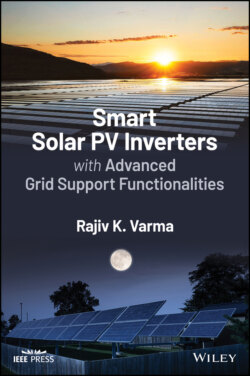Читать книгу Smart Solar PV Inverters with Advanced Grid Support Functionalities - Rajiv K. Varma - Страница 12
Оглавление
FOREWORD
During the course of my 33‐year career to date, I have had the privilege to contribute to a wide variety of activities associated with the application of Flexible AC Transmission Systems (FACTS) Controllers to improve power system dynamic behavior. This interest has taken me on a career journey with two different manufacturers, including direct experience on numerous utility‐scale FACTS installations.
Through our mutual interest with the application of power electronics‐based equipment to improve power system dynamic behavior, it was inevitable that Rajiv and I would meet by way of our common activities and volunteer work within the IEEE Power & Energy Society (PES) Transmission and Distribution (T&D) Committee and its HVDC and FACTS Subcommittee and participate in a number of its working groups including Performance and Modeling, Economics and Operating Strategies, and Education. Rajiv and I also interacted over the years on the subject of FACTS Controllers in the IEEE PES Substations Committee in multiple subcommittees and working groups. In addition, when I was an instructor in Bill Long's University of Wisconsin Engineering Professional Development program on the Dynamic Reactive Power Control Short Course series, Rajiv's book titled “Thyristor‐Based FACTS Controllers for Electrical Transmission Systems,” was the text for several editions of that course. Through these experiences, I became quite familiar with Rajiv’s work and contributions to FACTS and smart solar photovoltaic (PV) inverters.
With the advent of more cost‐effective equipment, along with the growing interest in decarbonization via renewable generation, the utilization of solar PV installations has grown significantly over the past decade and more. The application of this technology will continue to grow in the coming years as government mandates for Renewables Portfolio Standards (RPS) (or equivalent) increase and expand, while the total costs of PV installations continue to decrease. Beyond standard PV installations, which primarily focus on the control of the active power generated by the solar panels, lie opportunities for the application of smart solar PV inverters. Through advanced controls, smart solar PV inverters utilize the full range of capability for both active and reactive power, which in turn allows for a variety of benefits to improve power system dynamic behavior. These concepts are highlighted in detail in the various pages of this book.
Around 2009, Rajiv began to develop ground‐breaking techniques to transform solar PV inverters into the performance of a STATCOM, which provides various functionalities both during the night and day. Rajiv termed this advancement as PV‐STATCOM, which is essentially a new FACTS Controller. The PV‐STATCOM controls can provide several advanced grid support functions such as dynamic voltage control, power oscillation damping, mitigation of subsynchronous control interactions and torsional oscillations, improved Fault‐Induced Delayed Voltage Recovery (FIDVR), stabilization of remote critical motors, and fast frequency response, all of which can lead to improved dynamic performance, increased power transfer and load serving, and enhanced connectivity of neighboring wind plants and solar plants. It is worth noting that the PV‐STATCOM technology is about 10 times more economical than an equivalent‐sized STATCOM. This advancement by Rajiv, along with a field demonstration for the first time in 2016, is described in the various pages of this book in several chapters.
Rajiv, by providing this book to the industry, captures his career‐long dedication to, and knowledge of, power electronics‐based systems to improve dynamic performance. This book is a timely addition on the growing topic of smart solar PV installations. The topics cover a wide range of interest from smart PV inverter functions, modeling and control, applications (both distribution and transmission), hosting capacity, coordinated control, and emerging trends. The treatment further supports the characterization that the smart solar PV inverter, designated as PV‐STATCOM, is a new FACTS Controller. This book will be of great interest from beginners to experts in academia, research, and industry of all competencies including utilities, system operators, developers, integrators, regulators, manufacturers, and beyond.
John Paserba, Fellow IEEE
Vice President, Power Systems Group Mitsubishi Electric Power Products, Inc. (MEPPI) Warrendale, PA, USA
